Nov. 18 marks the 25th anniversary of when 12 Aggies died as the 2-million-pound log tower they were working on crashed to the ground. Another 27 Texas A&M University students were injured when the 59-foot stack of logs collapsed without warning; dozens of others escaped injury by jumping or falling to safety. KAMU is here with a few stories from the day — a survivor crushed in the disaster, a mother who lost her daughter and a firefighter who responded to the university’s worst disaster in its history. We also interviewed a current student reflecting on why it’s essential to Aggies that we never forget the lives lost a quarter of a century ago.
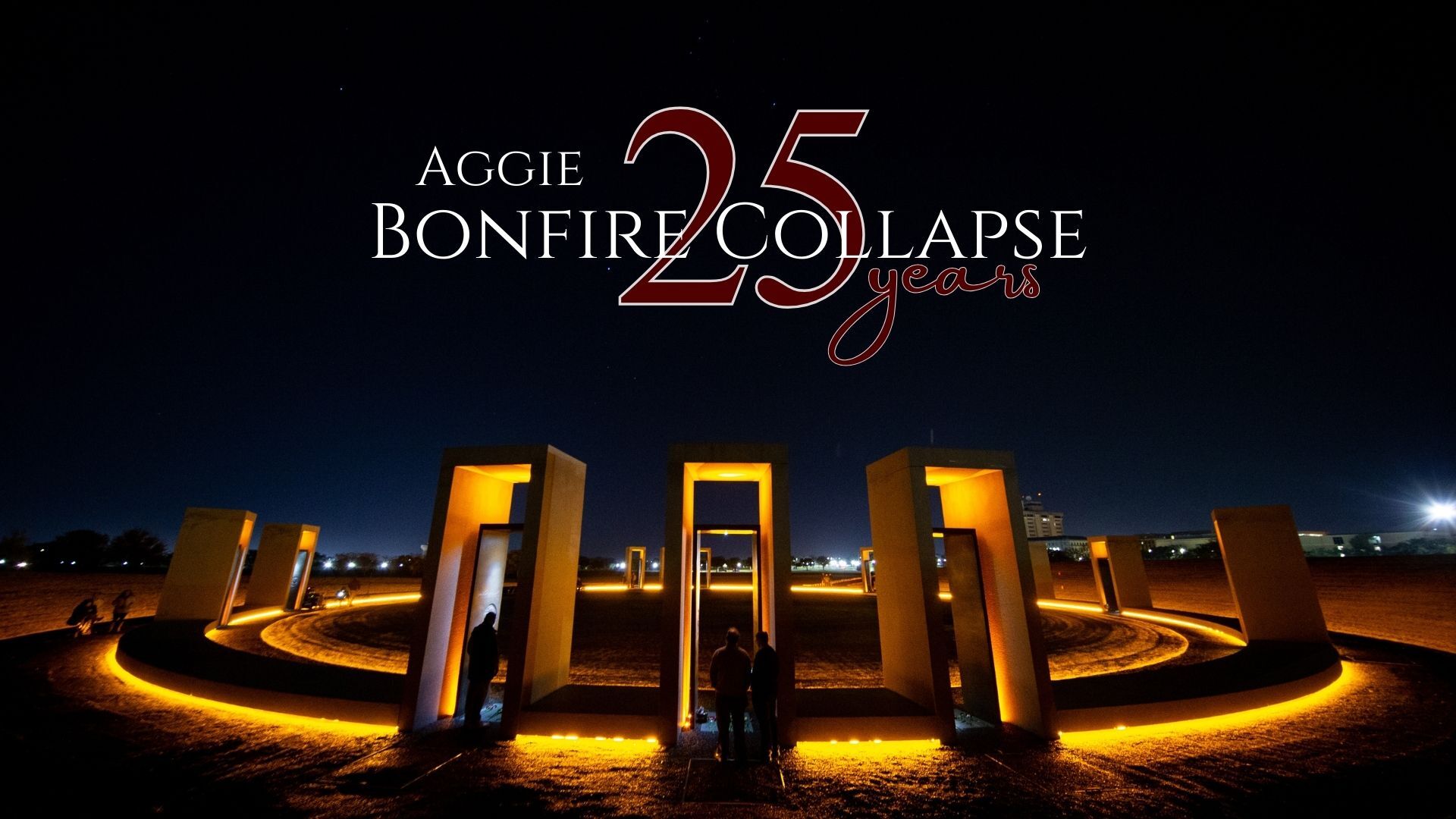
Watch KAMU’s 25th Anniversary Video
2024 Bonfire Remembrance
Learn how Texas A&M is remembering the 25th anniversary of the collapse
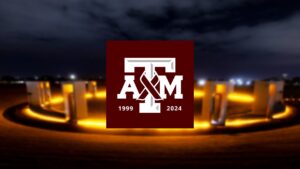
Join the Aggie family Nov. 18 at 2:42 a.m. to remember the 11 students and one former student who perished while building Bonfire. Each year on the anniversary of the collapse and at the exact time of the accident, thousands within the Aggie community gather at the site where bonfire once stood for a solemn ceremony. The circular memorial designed with a sense of quiet dignity and built to honor what took place educates visitors about the lives of the 12 Aggies and reinforces the university’s commitment to never forget them.
The Bonfire Remembrance Reflections Display is open in the MSC Flag Room, featuring photographs and information about the 11 students and one former student who died. There will also be a memorial display in the lobby of the Jack K. Williams Administration Building which will be open to the public from midnight until 2 a.m. on Nov. 18. Tributes are also planned as part of the Nov. 16 football game against New Mexico State.
 Nearly all current students weren’t born when the collapse happened, yet many will spend their early morning together, saying “here” for Miranda Denise Adams ’02, Christopher D. Breen ’96, Michael Stephen Ebanks ’03, Jeremy Richard Frampton ’99, Jamie Lynn Hand ’03, Christopher Lee Heard ’03, Timothy Doran Kerlee, Jr. ’03, Lucas John Kimmel ’03, Bryan A. McClain ’02, Chad A. Powell ’03, Jerry Don Self ’01 and Nathan Scott West ’02.
Nearly all current students weren’t born when the collapse happened, yet many will spend their early morning together, saying “here” for Miranda Denise Adams ’02, Christopher D. Breen ’96, Michael Stephen Ebanks ’03, Jeremy Richard Frampton ’99, Jamie Lynn Hand ’03, Christopher Lee Heard ’03, Timothy Doran Kerlee, Jr. ’03, Lucas John Kimmel ’03, Bryan A. McClain ’02, Chad A. Powell ’03, Jerry Don Self ’01 and Nathan Scott West ’02.
Read about the 12 fallen Aggies we remember each year
These Aggies ranged in age between 17 and 25; seven served in the Corps of Cadets; all were high achievers — driven; each had an undeniable passion for their school. For their families and friends, as well as the 27 injured in the catastrophe, the healing will never be complete, but there’s a bit of comfort in knowing there’s a place where the name of their loved one lives on, etched into granite for others to discover and remember.
Bonfire Memorial Cleaning
Each year, about a week before the Bonfire Remembrance ceremony, volunteers gather to clean Bonfire Memorial. Hear what goes into scrubbing, washing and waxing the memorial in this episode of “Unsung Talents,” a KAMU audio series.
Audio Player
Aggie Bonfire Remembrance Photo Gallery
This photo gallery contains pictures of the annual Bonfire Memorial cleaning and polishing, the Bonfire Remembrance ceremony and the Bonfire Reflections Display.
Aggie Bonfire History
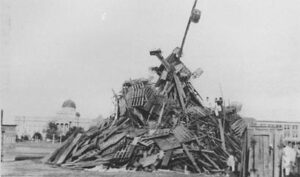 The first Bonfire on campus burned in 1909 and was little more than a pile of trash and some wood. It was built to symbolize Texas A&M University’s burning desire to beat its rival, the University of Texas, and it also stood for the undying flame of love that every Aggie has for its school. The size and look of the structure changed dramatically over the decades. The 1969 stack made history when — at 109 feet and 10 inches tall — it broke a world record for the height of a bonfire. Administrators at the time told leaders of the student-run project that the maximum height could be 55 feet. In 1978, a wedding cake-style tiered design was introduced, replacing the previous teepee configuration.
The first Bonfire on campus burned in 1909 and was little more than a pile of trash and some wood. It was built to symbolize Texas A&M University’s burning desire to beat its rival, the University of Texas, and it also stood for the undying flame of love that every Aggie has for its school. The size and look of the structure changed dramatically over the decades. The 1969 stack made history when — at 109 feet and 10 inches tall — it broke a world record for the height of a bonfire. Administrators at the time told leaders of the student-run project that the maximum height could be 55 feet. In 1978, a wedding cake-style tiered design was introduced, replacing the previous teepee configuration.
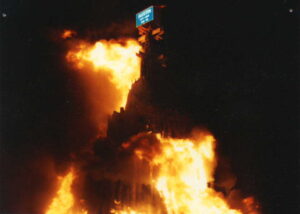 The construction process for the Aggie Bonfire kicked off nearly two months before the scheduled burn date. It started with cutting down trees, eventually bringing more than 5,000 logs to the Polo Fields at the entrance to campus. Thousands of students worked shifts — mostly coming from the Corps of Cadets and residence halls across campus. Utility poles, wires, cranes and swings helped the stack take shape. Toward the end of construction, students worked around the clock to complete it.
The construction process for the Aggie Bonfire kicked off nearly two months before the scheduled burn date. It started with cutting down trees, eventually bringing more than 5,000 logs to the Polo Fields at the entrance to campus. Thousands of students worked shifts — mostly coming from the Corps of Cadets and residence halls across campus. Utility poles, wires, cranes and swings helped the stack take shape. Toward the end of construction, students worked around the clock to complete it.
More than 70,000 people typically turned out to watch it burn, though attendance fluctuated if it was a rough season. Current and former students dominated the crowd while fans from the other school down the road also showed up to watch as the stack — doused in jet fuel — was set ablaze. Like on football game weekends, hotels in the region were sold out months in advance.
Two Bonfires did not burn. In 1963, the stack was taken apart after the assassination of President John F. Kennedy. And 1999. It was to be the 90th Aggie Bonfire until a loud pop in the middle of the night changed everything. More than 70 students were doing their best to make sure it was finished — their deadline was one week out and they were on target to meet their goal.
Nightmare in Aggieland
 The 2-million-pound structure buckled and fell apart without warning, collapsing in less than 10 seconds. Several Aggies fell from the top of the 59-foot stack and were killed instantly, according to authorities who said several dozen students were able to walk away unscathed – at least on the outside. Student medics, who were always on site, immediately moved into triage mode. Within the first hour of the collapse, 27 victims were transferred to local hospitals. By mid-afternoon, the parents of most of the 12 who died received confirmation that their child perished in the calamity.
The 2-million-pound structure buckled and fell apart without warning, collapsing in less than 10 seconds. Several Aggies fell from the top of the 59-foot stack and were killed instantly, according to authorities who said several dozen students were able to walk away unscathed – at least on the outside. Student medics, who were always on site, immediately moved into triage mode. Within the first hour of the collapse, 27 victims were transferred to local hospitals. By mid-afternoon, the parents of most of the 12 who died received confirmation that their child perished in the calamity.
Two students were pulled from the pile alive with the final person being pinned under the logs for almost seven hours with only his arm visible to rescuers.
Scores of emergency responders from more than 30 agencies responded to the scene, including Texas Task Force I, the FEMA urban search and rescue team based in College Station. Logs had to be removed by hand, one at a time, like pick up sticks, for fear that using heavy equipment would cause more harm. Search cameras were used to locate trapped students. Thousands of students and community members gathered on the perimeter of the disaster and stood or sat quietly watching in horror – and sadness. Cadets, along with the football coach and his players, aided rescuers by moving logs that had been plucked from the pile.
Powerful Reminders
Spontaneous tributes were made on and around the orange fencing placed around the perimeter of the field: Flowers, prayer cards, 12th Man towels, bonfire “pots,” rosaries, letters, stuffed animals and photos of the 12 who died, crosses for each and pocket Bibles. About 3,500 items were picked up later by an associate professor in the Department of Anthropology and her students, creating the Bonfire Memorabilia Collection Project. It resides in hundreds of boxes now cared for by the archivist for the university and kept at a building off Agronomy Road.
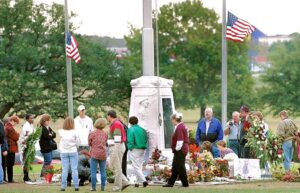 Not far from the Aggie Bonfire site, scores of people left similar items at the base of the university’s main flagpole at the entrance to campus. Of all the memorabilia left, it was a piece of jewelry that made a lasting impression on so many. A senior took off his Aggie ring and left it, along with a note that read: “To our fallen Aggies. I want you all to wear my Ring today since you who have passed away will never get to experience the joy and happiness I was fortunate enough to feel. I want you all to have my Ring for a while. You will remain in our hearts forever.”
Not far from the Aggie Bonfire site, scores of people left similar items at the base of the university’s main flagpole at the entrance to campus. Of all the memorabilia left, it was a piece of jewelry that made a lasting impression on so many. A senior took off his Aggie ring and left it, along with a note that read: “To our fallen Aggies. I want you all to wear my Ring today since you who have passed away will never get to experience the joy and happiness I was fortunate enough to feel. I want you all to have my Ring for a while. You will remain in our hearts forever.”
 In classic Aggie spirit, 30 other Aggies did the same. An honor guard from the Corps of Cadets stood watch over the rings, each meticulously engraved with its owner’s name and class year. In the end, all but one ring was returned to its owner: A graduate from 1983 did not expect to have his coveted ring returned and made sure of it by scratching out his name. Today, that ring is on display as part of the Rings of Significance collection at The Association of Former Students.
In classic Aggie spirit, 30 other Aggies did the same. An honor guard from the Corps of Cadets stood watch over the rings, each meticulously engraved with its owner’s name and class year. In the end, all but one ring was returned to its owner: A graduate from 1983 did not expect to have his coveted ring returned and made sure of it by scratching out his name. Today, that ring is on display as part of the Rings of Significance collection at The Association of Former Students.
Going Forward
A special commission appointed by then-President Ray Bowen investigated the collapse, hiring engineering firms and other experts to help learn how and why it happened. More than five months later, the commission filed its 261-page report. Structural failures caused the collapse and generations of administrators were identified as endorsing A&M’s cultural bias — labeled “tunnel vision” — and ignoring the reality of having unqualified students working on a massive construction project without proper supervision. No one administrator or student was blamed in the report that detailed safety issues at the stack over decades.
Following feedback sessions with students, former students, parents and the wider Aggie community, President Bowen announced in 2002 that the tradition would not return to campus. Unsuccessful attempts have been made over the past 20-plus years to have it return. An off-campus bonfire built by students and Aggie supporters burns each year and is not associated with the university.
Collapse and flagpole photos courtesy of The Eagle
Learn More
Learn more about the 1999 Aggie Bonfire collapse by visiting these links:
Texas A&M Marks 25th Anniversary Of Aggie Bonfire Collapse
Never Forgotten: 25 Years After Bonfire Tragedy, Texas A&M Remembers 12 Who Died
Bonfire Memorial Website
Read the Nov. 18, 1999 edition of The Battalion
Read the Nov. 19, 1999 edition of The Battalion
Vigil Replaces Bonfire, Nov. 26, 1999, The Eagle
20 Years Later: Bonfire Coverage from The Eagle
Read Bonfire Memorial coverage from My Aggie Nation (The Eagle)
The Aggie Bonfire Tragedy – Texas Monthly
Investigation Report Coverage from The Eagle
